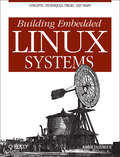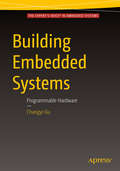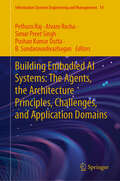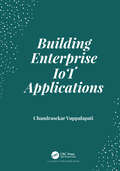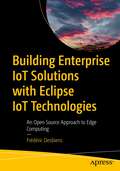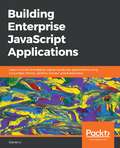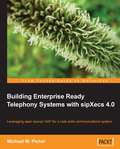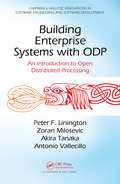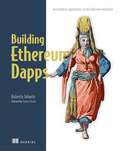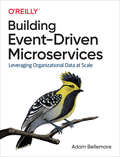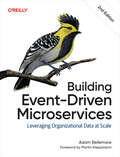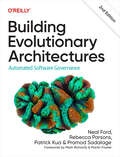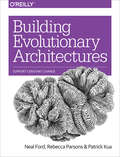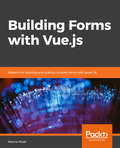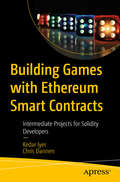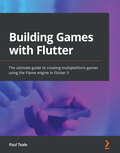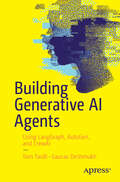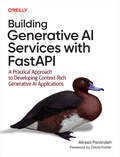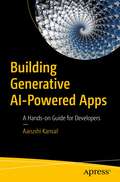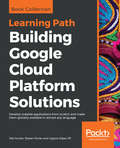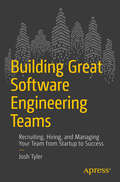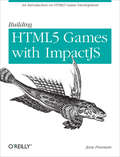- Table View
- List View
Building Embedded Linux Systems
by Karim YaghmourLinux® is being adopted by an increasing number of embedded systems developers, who have been won over by its sophisticated scheduling and networking, its cost-free license, its open development model, and the support offered by rich and powerful programming tools. While there is a great deal of hype surrounding the use of Linux in embedded systems, there is not a lot of practical information. Building Embedded Linux Systems is the first in-depth, hard-core guide to putting together an embedded system based on the Linux kernel. This indispensable book features arcane and previously undocumented procedures for:Building your own GNU development toolchain Using an efficient embedded development framework Selecting, configuring, building, and installing a target-specific kernel Creating a complete target root filesystem Setting up, manipulating, and using solid-state storage devices Installing and configuring a bootloader for the target Cross-compiling a slew of utilities and packages Debugging your embedded system using a plethora of tools and techniquesDetails are provided for various target architectures and hardware configurations, including a thorough review of Linux's support for embedded hardware. All explanations rely on the use of open source and free software packages. By presenting how to build the operating system components from pristine sources and how to find more documentation or help, this book greatly simplifies the task of keeping complete control over one's embedded operating system, whether it be for technical or sound financial reasons. Author Karim Yaghmour, a well-known designer and speaker who is responsible for the Linux Trace Toolkit, starts by discussing the strengths and weaknesses of Linux as an embedded operating system. Licensing issues are included, followed by a discussion of the basics of building embedded Linux systems. The configuration, setup, and use of over forty different open source and free software packages commonly used in embedded Linux systems are also covered. uClibc, BusyBox, U-Boot, OpenSSH, thttpd, tftp, strace, and gdb are among the packages discussed.
Building Embedded Systems: Programmable Hardware
by Changyi GuThis is a book about developing the software and hardware you never think about. We're talking about the nitty-gritty behind the buttons on your microwave, inside your thermostat, inside the keyboard used to type this description, and even running the monitor on which you are reading it now. Such stuff is termed embedded systems, and this book shows how to design and develop embedded systems at a professional level. Because yes, many people quietly make a successful career doing just that. Building embedded systems can be both fun and intimidating. Putting together an embedded system requires skill sets from multiple engineering disciplines, from software and hardware in particular. Building Embedded Systems is a book about helping you do things in the right way from the beginning of your first project: Programmers who know software will learn what they need to know about hardware. Engineers with hardware knowledge likewise will learn about the software side. Whatever your background is, Building Embedded Systems is the perfect book to fill in any knowledge gaps and get you started in a career programming for everyday devices. Author Changyi Gu brings more than fifteen years of experience in working his way up the ladder in the field of embedded systems. He brings knowledge of numerous approaches to embedded systems design, including the System on Programmable Chips (SOPC) approach that is currently growing to dominate the field. His knowledge and experience make Building Embedded Systems an excellent book for anyone wanting to enter the field, or even just to do some embedded programming as a side project. What you'll learn Program embedded systems at the hardware level Learn current industry practices in firmware development Develop practical knowledge of embedded hardware options Create tight integration between software and hardware Practice a work flow leading to successful outcomes Build from transistor level to the system level Make sound choices between performance and cost Who this book is for Building Embedded Systems: Programmable Hardware is for embedded-system engineers and intermediate electronics enthusiasts who are seeking tighter integration between software and hardware. Those who favor the System on a Programmable Chip (SOPC) approach will in particular benefit from this book. Students in both Electrical Engineering and Computer Science can also benefit from this book and the real-life industry practice it provides.
Building Embodied AI Systems: The Agents, the Architecture Principles, Challenges, and Application Domains (Information Systems Engineering and Management #14)
by Pethuru Raj Alvaro Rocha Simar Preet Singh B. Sundaravadivazhagan Pushan Kumar DuttaThis book is primed to demystify the emerging and evolving trend of embodied systems. It explains how these unique systems facilitate establishing smarter environments such as multi-specialty hospitals, manufacturing floors, warehouses, retail stores, defense zones, eating joints, entertainment plazas, etc., in detail for the benefit of our esteemed readers. To get a complete and actionable understanding of any mission-critical environment, we must deploy embodied systems. These systems, such as robots, drones, etc., are physical entities that are embedded and empowered with software systems. They interact with the environment in real time, providing context-aware services. There are chapters exclusively delineating the technologies behind the realization and deployment of such enigmatic systems. The prominent industrial use cases are explained in the latter chapters.
Building Enterprise IoT Applications
by Chandrasekar VuppalapatiMcKinsey Global Institute predicts Internet of Things (IoT) could generate up to $11.1 trillion a year in economic value by 2025. Gartner Research Company expects 20 billion inter-connected devices by 2020 and, as per Gartner, the IoT will have a significant impact on the economy by transforming many enterprises into digital businesses and facilitating new business models, improving efficiency and increasing employee and customer engagement. It’s clear from above and our research that the IoT is a game changer and will have huge positive impact in foreseeable future. In order to harvest the benefits of IoT revolution, the traditional software development paradigms must be fully upgraded. The mission of our book, is to prepare current and future software engineering teams with the skills and tools to fully utilize IoT capabilities. The book introduces essential IoT concepts from the perspectives of full-scale software development with the emphasis on creating niche blue ocean products. It also: Outlines a fundamental full stack architecture for IoT Describes various development technologies in each IoT layer Explains IoT solution development from Product management perspective Extensively covers security and applicable threat models as part of IoT stack The book provides details of several IoT reference architectures with emphasis on data integration, edge analytics, cluster architectures and closed loop responses.
Building Enterprise IoT Solutions with Eclipse IoT Technologies: An Open Source Approach to Edge Computing
by Frédéric DesbiensBuild IoT solutions for the enterprise using open-source building blocks from the Eclipse IoT Working Group at the Eclipse Foundation. This book introduces you to key protocols and their implementations, such as CoAP (Eclipse Californium), DDS (Eclipse Cyclone DDS), LwM2M (Eclipse Leshan), and MQTT (Eclipse Paho, Eclipse Mosquitto, and Eclipse Amlen). You will learn about Edge Computing platforms (Eclipse ioFog, Eclipse Kanto), IoT gateways (Eclipse Kura, Eclipse Kapua), and next-generation edge native protocols (Eclipse zenoh).The book also covers production-ready platforms for digital twins (Eclipse Ditto), energy management (Eclipse VOLTTRON), contactless payments (Eclipse Keyple), and much more.Although the book discusses hardware matters, its focus is on software and relevant open standards. The book helps you understand the pros and cons of the technologies available from Eclipse IoT and how they have been used in actual deployments. The examples provided cover a variety of use cases, such as industrial automation, smart agriculture, digital buildings, robotics, and others.The book's contents follow a reference architecture encompassing constrained devices (things), edge devices (gateways, servers), and IoT Cloud platforms. For each of those three pillars, you will learn about relevant open-source components. Usage of code libraries and frameworks is explained through code samples. You will also learn how to deploy and configure platform-type components and how to leverage them. Special attention will be paid to security and edge computing throughout the book. What You Will LearnDescribe in your own words the main software components required in an IoT architectureSelect the appropriate IoT protocols, components, frameworks, and platforms for a specific projectEvaluate the connectivity options at your disposal and select the most appropriate onesExplain the value of business models focused on open-source components and deploy such models in your organizationDetermine if edge computing is relevant to a project and deploy the relevant components on an edge computing platformBuild Enterprise IoT solutions leveraging an array of open-source components and platforms using popular languages such as C, Java, and RustWho This Book Is ForDevelopers new to enterprise IoT who want to learn about fundamental technologies for that market segment and seek an introduction to relevant, open-source building blocks; experienced IoT developers who seek alternatives to the proprietary platforms they are currently using; software architects designing IoT solutions who want to understand open-source technology options
Building Enterprise JavaScript Applications: Learn to build and deploy robust JavaScript applications using Cucumber, Mocha, Jenkins, Docker, and Kubernetes
by Daniel LiBecome a senior developer by building enterprise applications that use modern techniques such as TDD, containerization, continuous integration, and deploymentKey FeaturesCreate production-grade JavaScript applications from scratchBuild microservices and deploy them to a Docker container for scaling applicationsTest and deploy your code with confidence using Travis CIBook DescriptionWith the over-abundance of tools in the JavaScript ecosystem, it's easy to feel lost. Build tools, package managers, loaders, bundlers, linters, compilers, transpilers, typecheckers - how do you make sense of it all?In this book, we will build a simple API and React application from scratch. We begin by setting up our development environment using Git, yarn, Babel, and ESLint. Then, we will use Express, Elasticsearch and JSON Web Tokens (JWTs) to build a stateless API service. For the front-end, we will use React, Redux, and Webpack.A central theme in the book is maintaining code quality. As such, we will enforce a Test-Driven Development (TDD) process using Selenium, Cucumber, Mocha, Sinon, and Istanbul. As we progress through the book, the focus will shift towards automation and infrastructure. You will learn to work with Continuous Integration (CI) servers like Jenkins, deploying services inside Docker containers, and run them on Kubernetes.By following this book, you would gain the skills needed to build robust, production-ready applications.What you will learnPractice Test-Driven Development (TDD) throughout the entire bookUse Cucumber, Mocha and Selenium to write E2E, integration, unit and UI testsBuild stateless APIs using Express and ElasticsearchDocument your API using OpenAPI and SwaggerBuild and bundle front-end applications using React, Redux and WebpackContainerize services using DockerDeploying scalable microservices using KubernetesWho this book is forIf you're a JavaScript developer looking to expand your skillset and become a senior JavaScript developer by building production-ready web applications, then this book is for you.
Building Enterprise Ready Telephony Systems with sipXecs 4.0
by Michael W. PicherThis book was written to be a step by step approach to building a communications system for any organization. Care was taken to clearly illustrate with diagrams and screen shots all of the steps and concepts along the way. This book is written for network engineers who have been asked to deploy and maintain communications systems for their organizations.
Building Enterprise Systems with ODP: An Introduction to Open Distributed Processing
by Antonio Vallecillo Peter F. Linington Zoran Milosevic Akira TanakaThe Reference Model of Open Distributed Processing (RM-ODP) is an international standard that provides a solid basis for describing and building widely distributed systems and applications in a systematic way. It stresses the need to build these systems with evolution in mind by identifying the concerns of major stakeholders and then expressing the
Building Ethereum Dapps: Decentralized applications on the Ethereum blockchain
by Roberto InfanteSummaryBuilding Ethereum Dapps introduces you to decentralized applications based on the Ethereum blockchain platform. In this book, you'll learn the principles of Dapps development by rolling up your sleeves and actually building a few!Foreword by Thomas Bertani.Purchase of the print book includes a free eBook in PDF, Kindle, and ePub formats from Manning Publications.About the TechnologyImagine unbreakably secure applications that handle personal and business transactions without any central agency controlling the process. Decentralized applications, or Dapps, do just this, shifting power to users. The Ethereum blockchain platform provides the tools you need to build Dapps, including an innovative "smart contracts" model and Solidity, a Dapp-aware JavaScript-like programming language.About the BookBuilding Ethereum Dapps teaches Dapps development on the Ethereum blockchain platform. You'll begin with a mental model of how Dapps operate, and then dive into designing and implementing smart contracts in Ethereum's Solidity language. You'll explore Ethereum smart contract development tools, like Truffle and Web3, and pick up best practices for design and security. Practical exercises throughout give you valuable hands-on experience. What's insideEthereum's key componentsImplementing smart contracts in SolidityCommunicating with a smart contract in Web3Developing Dapps with TruffleBest practices for design and security improvementAbout the ReaderFor developers with intermediate experience in JavaScript or an OO language. Familiarity with blockchain concepts is helpful.About the AuthorRoberto Infante is a software development consultant who specializes in finance. He currently works on financial risk management systems and on blockchain technology.Table of ContentsPART 1A first look at decentralized applicationsUnderstanding the blockchainThe Ethereum platformDeploying your first smart contractPART 2Programming smart contracts in SolidityWriting more complex smart contractsGeneralizing functionality with abstract contracts and interfacesManaging smart contracts with Web3.jsPART 3The Ethereum ecosystemUnit testing contracts with MochaImproving the development cycle with TrufflePutting it all together: Building a complete voting DappPART 4Making a Dapp production readySecurity considerationsConclusions
Building Event-Driven Microservices: Leveraging Organizational Data At Scale
by Adam BellemareOrganizations today often struggle to balance business requirements with ever-increasing volumes of data. Additionally, the demand for leveraging large-scale, real-time data is growing rapidly among the most competitive digital industries. Conventional system architectures may not be up to the task. With this practical guide, you’ll learn how to leverage large-scale data usage across the business units in your organization using the principles of event-driven microservices.Author Adam Bellemare takes you through the process of building an event-driven microservice-powered organization. You’ll reconsider how data is produced, accessed, and propagated across your organization. Learn powerful yet simple patterns for unlocking the value of this data. Incorporate event-driven design and architectural principles into your own systems. And completely rethink how your organization delivers value by unlocking near-real-time access to data at scale.You’ll learn:How to leverage event-driven architectures to deliver exceptional business valueThe role of microservices in supporting event-driven designsArchitectural patterns to ensure success both within and between teams in your organizationApplication patterns for developing powerful event-driven microservicesComponents and tooling required to get your microservice ecosystem off the ground
Building Event-Driven Microservices: Leveraging Organizational Data at Scale
by Adam BellemareEvent-driven microservices offer an optimal approach to harnessing event streams, reacting and responding to changes as they occur across your company. With this fully revised and updated guide, you’ll learn how to apply the principles of event-driven architecture to create event streams and build powerful microservice applications. Author Adam Bellemare takes you through the process of creating event-driven microservice architectures, from first principles all the way to advanced applications. Covering events, event streams, and microservices, this book will give you powerful and reusable patterns for sharing and using important data all across your organization. The theory and principles of event-driven architectures How to design and build event-driven microservice architectures to deliver exceptional business value Event and event-stream design patterns, including schemas and evolution through time Microservice application patterns, both as singular services and as a collection of multiple services Tooling and techniques to get your event-driven microservice ecosystem off the ground and set yourself up for success Integrating event-driven applications into your existing architecture
Building Evolutionary Architectures: Automated Software Governance
by Neal Ford Rebecca Parsons Patrick Kua Pramod SadalageThe software development ecosystem is constantly changing, providing a constant stream of new tools, frameworks, techniques, and paradigms. Over the past few years, incremental developments in core engineering practices for software development have created the foundations for rethinking how architecture changes over time, along with ways to protect important architectural characteristics as it evolves. This practical guide ties those parts together with a new way to think about architecture and time.
Building Evolutionary Architectures: Support Constant Change
by Neal Ford Rebecca Parsons Patrick KuaThe software development ecosystem is constantly changing, providing a constant stream of new tools, frameworks, techniques, and paradigms. Over the past few years, incremental developments in core engineering practices for software development have created the foundations for rethinking how architecture changes over time, along with ways to protect important architectural characteristics as it evolves. This practical guide ties those parts together with a new way to think about architecture and time.
Building Expert Business Solutions with Zoho CRM: An indispensable guide to developing future-proof CRM solutions and growing your business exponentially
by Dominic HarringtonCreate world-class Zoho CRM solutions tailored to be a game changer for your business and transform the way you collect, manage, and use customer dataKey FeaturesUnlock the full potential of advanced Zoho CRM features to supercharge your business solutionsCustomize your Zoho CRM solutions to achieve scalable and long-term customer engagementStreamline your entire business for digital transformation by integrating CRM with different Zoho products and applicationsBook DescriptionZoho CRM is one of the most user-friendly, configurable, and competitively priced CRM systems for managing all your customer relationships. When tailored effectively to your business, it empowers your team to work smarter and helps your business to achieve more profitable and scalable growth. This book will show you how to make the most of Zoho CRM to increase productivity. You'll start by learning about the foundation modules of Zoho CRM such as Leads, Deals, Contacts, and Accounts, and understand their functionalities that enable you to build effective solutions. Then, you'll explore innovative workflows that will help you to save time and make sure that your sales teams are proactively managing opportunities and clients. The book also focuses on Zoho Marketplace, as well as how to extend the functionality of Zoho CRM using custom functions. You'll cover real-world use cases that will inspire you to extend your Zoho adoption by integrating Zoho CRM with other Zoho apps such as Zoho Campaigns, Zoho Forms, Zoho Survey, and SalesIQ. Finally, you'll discover best practices for adapting and evolving your CRM solutions and maintaining your CRM to achieve continuous improvement. By the end of this CRM book, you'll have set up a CRM solution that will be fit for the next 10 years of business growth.What you will learnManage customer relationships and acquire new customers quicklyUnderstand the importance of Leads, Deals, Contacts, and Accounts modulesUse game-changing workflows and automation to manage opportunities and clientsExplore how custom functions can extend the functionality of your CRMIntegrate Zoho CRM with other Zoho apps such as Zoho Campaigns, Forms, Survey, and CreatorDiscover how to keep your CRM fit for the future and achieve continuous growthWho this book is forThis book is for you if you're a business manager or a business owner interested in learning how the Zoho platform can help transform your business and are looking to gain a practical understanding of how to choose an app from the vast array of Zoho products. Whether you're new to Zoho or have basic experience and want to learn more about its features and apps, this book can help you. Expert Zoho users who want to develop custom solutions for their business will also find this book useful. Foundational knowledge of CRM concepts is expected to get the most out of this book.
Building Forms with Vue.js: Patterns For Building And Scaling Complex Forms With Great Ux
by Marina MostiThis book is intended for any developer with basic Vue experience who wants to enhance their forms. No previous experience with any of the libraries used in the book is required.
Building Games with Ethereum Smart Contracts: Intermediate Projects For Solidity Developers
by Chris Dannen Kedar IyerLearn how to take your existing knowledge of Ethereum and Solidity to the next level. Hone your development skills and become more familiar with the syntax of the Solidity language by working through well-tested, well-documented intermediate-level sample projects.You will begin by covering the basics of Ethereum, Solidity, and gaming theory. From there, you will move onto sample projects that use smart contract engineering to create fun casino-style games that you can deploy and test on your friends and colleagues with real ether. All games are provably fair and auditable, so that players know the house won’t always win!Ideal for any reader with exposure to Ethereum, the techniques this book teaches are applicable to game developers, software engineers, web developers, and cryptocurrency enthusiasts.What You'll LearnUse various features and best practices for smart contract programming in Ethereum and SolidityDevelop and deploy games of chance, similar to the kind you’d find in a casinoCreate fun, easy projects with Ethereumlntegrate the Ethereum blockchain into gamesWho This Book Is ForEntry-level programmers with some exposure to Ethereum; game developers, Blockchain and cryptocurrency enthusiasts looking to add Ethereum and Solidity development to their skill set; software engineers and Web developers
Building Games with Flutter: The ultimate guide to creating multiplatform games using the Flame engine in Flutter 3
by Paul TealeBuild a complete game from start to finish using Flutter and Flame while getting acquainted with each building block in game design along the wayKey FeaturesBegin your Flutter game development journey with step-by-step instructions and best practicesUnderstand the Flame game engine and its essential elements for making games, sprite animation, tilemaps, and audioBuild enjoyable games with Flutter that can be played across different platformsBook DescriptionWith its powerful tools and quick implementation capabilities, Flutter provides a new way to build scalable cross-platform apps. In this book, you'll learn how to build on your knowledge and use Flutter as the foundation for creating games.This game development book takes a hands-on approach to building a complete game from scratch. You'll see how to get started with the Flame library and build a simple animated example to test Flame. You'll then discover how to organize and load images and audio in your Flutter game. As you advance, you'll gain insights into the game loop and set it up for fast and efficient processing. The book also guides you in using Tiled to create maps, add sprites to the maps that the player can interact with, and see how to use tilemap collision to create paths for a player to walk on. Finally, you'll learn how to make enemies more intelligent with artificial intelligence (AI).By the end of the book, you'll have gained the confidence to build fun multiplatform games with Flutter.What you will learnDiscover the Flame engine and how to use it in game programming in FlutterOrganize the graphics and sounds used in your gameAnimate a sprite in your games and detect when the player collides with tilesRun the game as a web page and desktop appExpand our player control with key navigationBuild your first game and make your enemies more intelligent with AI for gamesWho this book is forIf you are a Flutter developer looking to apply your Flutter programming skills to games development, this book is for you. Basic knowledge of Dart will assist with understanding the concepts covered.
Building Generative AI Agents: Using LangGraph, AutoGen, and CrewAI
by Tom Taulli Gaurav DeshmukhThe dawn of AI agents is upon us. Tech visionaries like Bill Gates, Andrew Ng, and Vinod Khosla have highlighted the monumental potential of this powerful technology. This book will provide the knowledge and tools necessary to build generative AI agents using the most popular frameworks, such as AutoGen, LangChain, LangGraph, CrewAI, and Haystack. Recent breakthroughs in large language models have opened up unprecedented possibilities. After years of gradual progress in machine learning and deep learning, we are now witnessing novel approaches capable of understanding, reasoning, and generating content in ways that promise to revolutionize nearly every industry. This platform shift is as significant as the advent of mainframes, PCs, cloud computing, mobile technology, and social media. It’s why the world’s largest technology companies – like Microsoft, Apple, Google, and Meta – are making enormous investments in this category. While chatbots like ChatGPT, Claude, and Gemini have demonstrated remarkable potential, the years ahead will see the rise of generative AI agents capable of executing complex tasks on behalf of users. These agents already exhibit capabilities such as running test suites, searching the web for documentation, writing software, answering questions based on vast organized information, and performing intricate web-based tasks across multiple domains. They can autonomously investigate cybersecurity incidents and address complex customer support needs. By integrating skills, knowledge bases, planning frameworks, memory, and feedback loops, these systems can handle many tasks and improve over time. Building Generative AI Agents serves as a high-quality guide for developers to understand when and where AI agents can be useful, their advantages and disadvantages, and practical advice on designing, building, deploying, and monitoring them. What You Will Learn The foundational concepts, capabilities, and potential of AI agents. Recent innovations in large language models that have enabled the development of AI agents. How to build AI agents for launching a product, creating a financial plan, handling customer service, and using Retrieval Augmented Generation (RAG). Essential frameworks for building generative AI agents, including AutoGen, LangChain, LangGraph, CrewAI, and Haystack. Step-by-step guidance on designing, building, and deploying AI agents. Insights into the future of AI agents and their potential impact on various industries. Who This Book Is For Experienced software developers
Building Generative AI Services with FastAPI: A Practical Approach to Developing Context-Rich Generative AI Applications
by Alireza ParandehReady to build production-grade applications with generative AI? This practical guide takes you through designing and deploying AI services using the FastAPI web framework. Learn how to integrate models that process text, images, audio, and video while seamlessly interacting with databases, filesystems, websites, and APIs. Whether you're a web developer, data scientist, or DevOps engineer, this book equips you with the tools to build scalable, real-time AI applications. Author Alireza Parandeh provides clear explanations and hands-on examples covering authentication, concurrency, caching, and retrieval-augmented generation (RAG) with vector databases. You'll also explore best practices for testing AI outputs, optimizing performance, and securing microservices. With containerized deployment using Docker, you'll be ready to launch AI-powered applications confidently in the cloud.Build generative AI services that interact with databases, filesystems, websites, and APIsManage concurrency in AI workloads and handle long-running tasksStream AI-generated outputs in real time via WebSocket and server-sent eventsSecure services with authentication, content filtering, throttling, and rate limitingOptimize AI performance with caching, batch processing, and fine-tuning techniquesVisit the Book's Website.
Building Generative AI-Powered Apps: A Hands-on Guide for Developers
by Aarushi KansalGenerative AI has gone beyond the responsibility of researchers and data scientists and is being used by production engineers. However, there is a lot of confusion where to get started when building an end-to-end app with generative AI. This book consolidates core models, frameworks, and tools into a single source of knowledge. By providing hands-on examples, the book takes you through the generative AI ecosystem to build applications for production.The book starts with a brief and accessible introduction to transformer models before delving into some of the most popular large language models and diffusions models (image generation). These models are the foundations of both AI and your potential new apps. You will then go through various tools available to work with these models, starting with Langchain, a framework to develop foundational models, which is the next building block you should grasp after understanding generative AI models. The next chapters cover databases, caching, monitoring, etc., which are the topics necessary to build larger-scale applications. Real-world examples using these models and tools are included.By the end of this book, you should be able to build end-to-end apps that are powered by generative AI. You also should be able to apply the tools and techniques taught in this book to your use cases and business.What You Will LearnWhat is Generative AI?What is ChatGPT and GPT4?What are language models and diffusions models?How do we deploy LangChain and HuggingFace?Who This Book Is ForSoftware engineers with a few years of experience building applications in any language or infrastructure
Building Google Cloud Platform Solutions: Develop scalable applications from scratch and make them globally available in almost any language
by Steven Porter Ted Hunter Legorie Rajan PSBuild cost-effective and robust cloud solutions with Google Cloud Platform (GCP) using these simple and practical recipes Key Features Explore the various service offerings of the GCP Host a Python application on Google Compute Engine Securely maintain application states with Cloud Storage, Datastore, and Bigtable Book Description GCP is a cloud computing platform with a wide range of products and services that enable you to build and deploy cloud-hosted applications. This Learning Path will guide you in using GCP and designing, deploying, and managing applications on Google Cloud. You will get started by learning how to use App Engine to access Google's scalable hosting and build software that runs on this framework. With the help of Google Compute Engine, you'll be able to host your workload on virtual machine instances. The later chapters will help you to explore ways to implement authentication and security, Cloud APIs, and command-line and deployment management. As you hone your skills, you'll understand how to integrate your new applications with various data solutions on GCP, including Cloud SQL, Bigtable, and Cloud Storage. Following this, the book will teach you how to streamline your workflow with tools, including Source Repositories, Container Builder, and Stackdriver. You'll also understand how to deploy and debug services with IntelliJ, implement continuous delivery pipelines, and configure robust monitoring and alerts for your production systems. By the end of this Learning Path, you'll be well versed with GCP's development tools and be able to develop, deploy, and manage highly scalable and reliable applications. This Learning Path includes content from the following Packt products: Google Cloud Platform for Developers Ted Hunter and Steven Porter Google Cloud Platform Cookbook by Legorie Rajan PS What you will learn Host an application using Google Cloud Functions Migrate a MySQL database to Cloud Spanner Configure a network for a highly available application on GCP Learn simple image processing using Storage and Cloud Functions Automate security checks using Policy Scanner Deploy and run services on App Engine and Container Engine Minimize downtime and mitigate issues with Stackdriver Monitoring and Debugger Integrate with big data solutions, including BigQuery, Dataflow, and Pub/Sub Who this book is for This Learning Path is for IT professionals, engineers, and developers who want to implement Google Cloud in their organizations. Administrators and architects planning to make their organization more efficient with Google Cloud will also find this Learning Path useful. Basic understanding of GCP and its services is a must.
Building Great Software Engineering Teams: Recruiting, Hiring, and Managing Your Team from Startup to Success
by Josh TylerWINNER of Computing Reviews 20th Annual Best Review in the category Management “Tyler’s book is concise, reasonable, and full of interesting practices, including some curious ones you might consider adopting yourself if you become a software engineering manager.” —Fernando Berzal, CR, 10/23/2015 “Josh Tyler crafts a concise, no-nonsense, intensely focused guide for building the workhouse of Silicon Valley—the high-functioning software team.” —Gordon Rios, Summer Book Recommendations from the Smartest People We Know—Summer 2016Building Great Software Engineering Teams provides engineering leaders, startup founders, and CTOs concrete, industry-proven guidance and techniques for recruiting, hiring, and managing software engineers in a fast-paced, competitive environment.With so much at stake, the challenge of scaling up a team can be intimidating. Engineering leaders in growing companies of all sizes need to know how to find great candidates, create effective interviewing and hiring processes, bring out the best in people and their work, provide meaningful career development, learn to spot warning signs in their team, and manage their people for long-term success.Author Josh Tyler has spent nearly a decade building teams in high-growth startups, experimenting with every aspect of the task to see what works best. He draws on this experience to outline specific, detailed solutions augmented by instructive stories from his own experience. In this book you’ll learn how to build your team, starting with your first hire and continuing through the stages of development as you manage your team for growth and success. Organized to cover each step of the process in the order you’ll likely face them, and highlighted by stories of success and failure, it provides an easy-to-understand recipe for creating your high-powered engineering team.
Building Green Software: A Sustainable Approach to Software Development and Operations
by Anne Currie Sarah Hsu Sara BergmanHow will software development and operations have to change to meet the sustainability and green needs of the planet? And what does that imply for development organizations? In this eye-opening book, sustainable software advocates Anne Currie, Sarah Hsu, and Sara Bergman provide a unique overview of this topic—discussing everything from the likely evolution of national grids to the effect those changes will have on the day-to-day lives of developers.Ideal for everyone from new developers to CTOs, Building Green Software tackles the challenges involved and shows you how to build, host, and operate code in a way that's not only better for the planet but also cheaper and relatively low-risk for your business. Most hyperscale public cloud providers have already committed to net-zero IT operations by 2030. This book shows you how to get on board.You'll explore:How the energy transition is likely to change hosting on prem and in the cloud—and how your company can prepareThe fundamental architectural principles of sustainable software development and how to apply themHow to determine which parts of your system need to changeThe concept of extending hardware longevity and the part that software plays
Building HTML5 Games with ImpactJS: An Introduction On HTML5 Game Development
by Jesse FreemanCreate a real 2D game from start to finish with ImpactJS, the JavaScript game framework that works with the HTML5's Canvas element. Making video games is hard work that requires technical skills, a lot of planning, and—most critically—a commitment to completing the project. With this hands-on guide, you’ll learn how to use Impact with other technologies step-by-step.You’ll pick up important tips about game design, and discover how to publish Impact games to the Web, desktop, and mobile—including a method to package your game as a native iOS app. Packed with screen shots and sample code, this book is ideal for game developers of all levels.Set up your development environment and discover Impact’s advantagesBuild a complete game with core logic, collision detection, and player and monster behaviorLearn why a game design document is critical before you start buildingDisplay and animate game artwork with sprite sheetsAdd sound effects, background music, and textCreate screens to display stats and in-game statusPrepare to publish by baking your game files into a single file
Building Hawaii’s Innovation Economy: Summary of a Symposium
by Charles W. WessnerResponding to the challenges of fostering regional growth and employment in an increasingly competitive global economy, many U. S. states and regions have developed programs to attract and grow companies as well as attract the talent and resources necessary to develop innovation clusters. These state and regionally based initiatives have a broad range of goals and increasingly include significant resources, often with a sectoral focus and often in partnership with foundations and universities. These are being joined by recent initiatives to coordinate and concentrate investments from a variety of federal agencies that provide significant resources to develop regional centers of innovation, business incubators, and other strategies to encourage entrepreneurship and high-tech development. Building Hawaii's Innovation Economy: Summary of a Symposium explains the study of selected state and regional programs in order to identify best practices with regard to their goals, structures, instruments, modes of operation, synergies across private and public programs, funding mechanisms and levels, and evaluation efforts. This report reviews selected state and regional efforts to capitalize on federal and state investments in areas of critical national needs. Building Hawaii's Innovation Economy also reviews efforts to strengthen existing industries as well as specific new technology focus areas such as nanotechnology, stem cells, and energy in order to better understand program goals, challenges, and accomplishments.
